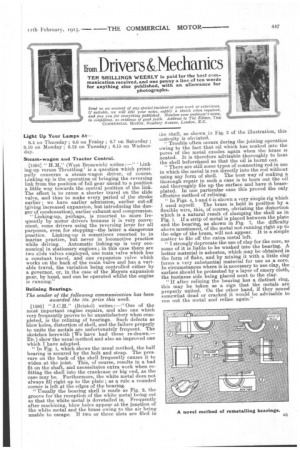E0 m Drivers &Mechanics
Page 21

If you've noticed an error in this article please click here to report it so we can fix it.
TEN SHILLINGS WEEKLY is paid for the best communication received, and one penny a line of ten words for anything else published, with an allowance for photographs.
Send us an account of any special incident of your work or experience. If suitable, we will edit your notes, supply a sketch when required, and pay you for everything published. Mention your employer's name, in confidence, as evidence of good faith. Address to The Editor, THE COMMERCIAL MOTOR, Rosebcry Avenue, London, E.C.
Light Up Your Lamps At 6.4 on Thursday ; 6.6 on Friday ; 6.7 on Saturday ; 6.10 on Monday ; 6.12 on Tuesday ; 6.16 on Wednesday.
Steam-wagon and Tractor Control.
[1594] " RM." (West Bromwich) writes :—" Linking-up versus Throttling' is a question which principally concerns a steam-wagon driver, of course. Linking up is the operation of bringing the reversing link from the position of full gear ahead to a position a little way towards the central position of the link. The effect Is to cause a shorter travel on the slide valve, and thus to make every period of the stroke earlier ; we have earlier admission, earlier cut-off (giving increased expansion, but introducing the danger of condensation), earlier exhaust and compression.
"Linking-up, perhaps, is resorted to more frequently by motor drivers because it is very convenient, some drivers using the reversing lever for all purposes, even for stopping—the latter a dangerous practice. Linking-up is sometimes resorted to in marine practice, but never in locomotive practice while driving. Automatic linking-up is very economical in stationary engines ; in this case there are two slide valves employed, one main valve which has a constant travel, and one expansion valve which works on the back of the main valve and has a variable travel, the variation being controlled either by a governor, or, in the ease of the Meyers expansion gear, by hand, and can be operated whilst the engine is running."
Relining Bearings.
The sender of the following communication has been awarded the Ws. prize this week.
[1595] " J.C.H." (Bristol) writes :—" One of the most important engine repairs, and also one which very frequently proves to be unsatisfactory when completed, is the relining of bearings. Such defects as blow holes, distortion of shell, and the failure properly to unite the metals are unfortunately frequent The sketches herewith [We have had these re-drawn.En.] show the usual method and also an improved one which I have adopted. "In Fig. 1, which shows the usual method, the half bearing is secured by the bolt and strap. The pressure on the back of the shell frequently causes it to widen at the joint. This, of course, results in a bad fit on the shaft, and necessitates extra work when refitting the shell into the crankcase or big end, as the case may be. Furthermore, the white metal does not always fill right up to the plate' as a rule a rounded corner is left at the edges of the bearing.
"Usually the bearing shell is made as Fig. 2, the groove for the reception of the white metal being cut so that the white metal is dovetailed in. Frequently after machining, blow holes appear at the junction of the white metal and the brass owing to the air being unable to escape. If two or three slots are filed in the shell, as shown in Fig. 3 of the illustration, this ainiculty is obviated. Trouble often occurs during the joining operation owing to the fact that oil which has soaked into the pores of the metal exudes again when the brass is neated. It is therefore advisable thoroughly to heat the shell beforehand so that the oil is burnt out.
" There are still some types of connecting rod in use in which the metal is run directly into the rod without using any form of shell. The best way of making a thorough repair in such a case is to burn out the oil and thoroughly file up the surface and have it brassplated. In one particular case this proved the only effective method of relining. "In Figs. 4, 5 and 6 is shown a very simple rig which I used myself. The brass is held in position by a flexible wire, this, of course, obviating the distortion which is a natural result of clamping the shell as in Fig. 1. If a strip of metal is placed between the plate and the bearing, as shown in Fig. 7, the difficulty above mentioned, of the metal not running right up to the edge of the brass, will not appear. It is a simple matter to file off the extra metal left.
" I strongly deprecate the use of clay for the core, as some of it is liable to be washed into the bearing. A better material is asbestos, which may be obtained in the form of flake, and by mixing it with a little clay forms a very substantial material for use as a core. In circumstances where it is necessary to use clay, the surface should be protected by a layer of emery cloth, the business side being placed next to the clay. " If after relining the bearing has a distinct ring, this may be taken as a sign that the metals are properly united. On the other hand, if they sound somewhat dead or cracked it would be advisable to run out the metal and reline again."






















